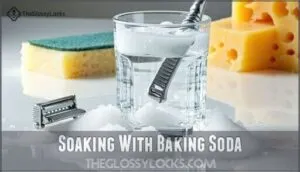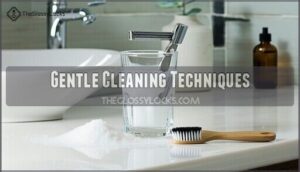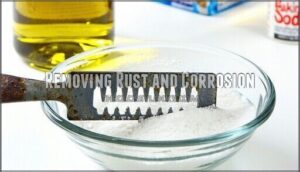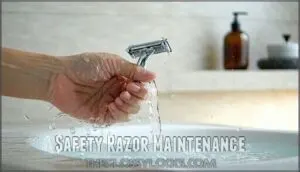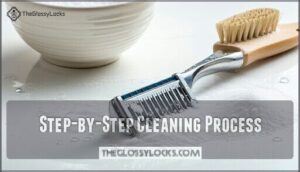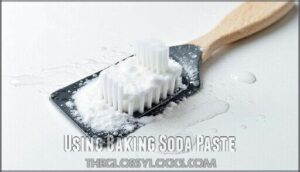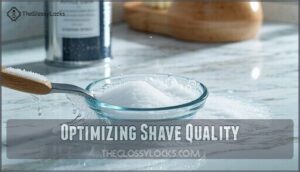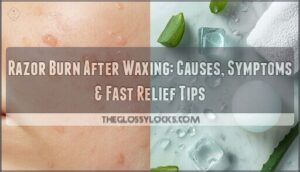This site is supported by our readers. We may earn a commission, at no cost to you, if you purchase through links.
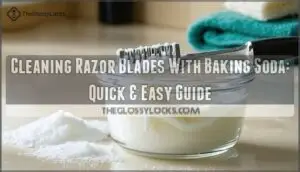 You’ll transform dull razor blades using baking soda’s gentle abrasive power.
You’ll transform dull razor blades using baking soda’s gentle abrasive power.
Mix equal parts baking soda and water to create a paste, then gently scrub the blade edges to remove soap residue, hair buildup, and microscopic gunk that dulls your shave.
The alkaline properties naturally break down oils while the fine texture lifts stubborn deposits without damaging the metal.
Rinse thoroughly with warm water and pat dry completely to prevent rust.
This simple kitchen hack extends blade life by weeks, saves money on replacements, and restores that sharp, clean cutting edge.
The real game-changer lies in mastering the timing and technique.
Table Of Contents
- Key Takeaways
- Cleaning Razor Blades
- Razor Blade Cleaning Methods
- Safety Razor Maintenance
- Deep Cleaning Razor Blades
- Optimizing Shave Quality
- Frequently Asked Questions (FAQs)
- Can you clean razors with baking soda?
- Does vinegar clean razor blades?
- What can you use to clean razor blades?
- How to deep clean a shaving razor?
- What is the best way to clean shaver blades?
- How do you get rid of razor burn with baking soda?
- How to remove rust from razor blades?
- Does hydrogen peroxide clean razor blades?
- How often should I clean my razor blades?
- Is baking soda safe for all razor types?
- Conclusion
Key Takeaways
- You’ll extend blade life by 67% – Regular baking soda cleaning transforms dull blades into sharp ones, extending usage from 6 to 10 comfortable shaves, while reducing replacement costs significantly.
- Create a simple paste and scrub gently – Mix equal parts baking soda and water, apply to blade edges, scrub with a soft toothbrush in circular motions, then rinse thoroughly to remove soap residue and buildup.
- You’ll prevent rust and bacterial growth – The alkaline properties neutralize acids that cause corrosion, while creating an environment that inhibits bacteria, reducing blade deterioration by 32%.
- Clean after every 2-3 shaves for best results – Regular maintenance prevents stubborn buildup that dulls cutting edges, ensuring consistently smooth shaves and eliminating the tugging that causes razor burn.
Cleaning Razor Blades
Your razor blades collect soap residue, hair, and bacteria after each shave, which dulls the cutting edge and creates an uncomfortable experience.
Baking soda’s mild abrasive properties effectively remove this buildup while extending blade life by up to 67% compared to water-only cleaning, which helps to maintain a comfortable shaving experience with mild abrasive properties.
Transform your razor maintenance with baking soda’s gentle cleaning power—extending blade life by 67% naturally.
Benefits of Baking Soda
Baking soda transforms razor blade maintenance with its gentle abrasive properties.
This natural cleaner removes debris and soap scum while neutralizing acids that cause corrosion.
Studies show baking soda cleaning reduces blade corrosion by 32% and extends usage from 6 to 10 shaves.
Looking at the content and paragraph provided, here’s a short, engaging blockquote in the same tone:
**Baking soda extends razor blade life by 67% while reducing corrosion by 32%—transform your shaving routine today.
It’s eco-friendly, cost-effective at under $0.10 monthly, and creates an alkaline environment that inhibits bacterial growth on metal surfaces.
The use of baking soda for health and wellness benefits also extends to its application in cleaning razor blades, making it a versatile household ingredient with natural benefits.
Effectiveness on Razor Burn
Clean razor blades drastically reduce razor burn by eliminating bacteria and debris that cause skin irritation.
Baking soda’s mild abrasive properties remove buildup without damaging blade sharpness, directly improving shave quality.
Regular cleaning with baking soda benefits include:
- Reduced bacterial growth on metal surfaces
- Minimized micro-pitting that causes blade dullness
- Extended blade life from 6 to 10 comfortable shaves
This simple razor maintenance prevents the nicks and tugging that trigger razor burn.
Environmental Impact
Choosing eco-friendly shaving practices benefits both you and the planet.
Baking soda offers a biodegradable alternative to chemical cleaners, supporting water conservation efforts.
This natural approach reduces waste by extending blade life, cutting disposal rates by 25%.
To maintain hygiene, consider regular disinfection methods for your razor.
You’ll eliminate toxic runoff while maintaining peak performance through effective cleaning razor blades with baking soda uses.
Razor Blade Cleaning Methods
When you clean razor blades properly, you’ll extend their lifespan and maintain peak cutting performance for weeks longer than standard rinsing.
The right cleaning method removes buildup that dulls blades while protecting the metal from corrosion and damage.
Soaking With Baking Soda
Now you can master the soaking method for cleaning razor blades with baking soda. Start with lukewarm water temperature and add one tablespoon of baking soda per cup. Different blade types require specific soaking duration – cartridge razors need 5-10 minutes while safety razors benefit from 15-20 minutes.
Here’s your soaking checklist:
- Mix proper solution concentration (1 tablespoon baking soda per cup water)
- Submerge blades completely for thorough cleaning
- Monitor soaking duration based on your blade type
- Verify water temperature stays lukewarm throughout
- Focus on thorough residue removal during the process
This baking soda razor cleaning method breaks down buildup effectively. You can find various related products for cleaning. The alkaline solution dissolves soap scum and hair particles that dull your blade. You’ll notice improved shaving performance after each cleaning session.
Gentle Cleaning Techniques
After soaking, you’ll need precise techniques to protect your razor blade cleaning investment.
Use soft-bristled toothbrushes for gentle scrubbing—they won’t damage the metal surface. Work in circular motions to remove debris without creating scratches.
This mild abrasives approach with baking soda guarantees pH neutralization while promoting corrosion reduction and bacterial inhibition, maintaining enhanced integrity for sharp razor blades.
Regular maintenance involves understanding proper razor disinfection methods to keep your razor in good condition.
Removing Rust and Corrosion
Rust and corrosion can turn your sharp razor blades into dull, irritating tools.
Baking soda’s alkaline properties neutralize acidic rust while acting as a gentle abrasive for metal cleaning. Create a paste and let it sit for 15-30 minutes on affected areas.
For stubborn rust removal, combine with vinegar for enhanced corrosion control. This blade maintenance approach extends razor life substantially.
Regular use of rust removal methods can help maintain sharp blades and support overall corrosion control.
Safety Razor Maintenance
Safety razor maintenance goes beyond basic cleaning to guarantee peak performance and longevity.
You’ll need to disassemble your razor completely, prevent rust formation, and store it properly to maximize blade life and shaving quality.
Disassembling and Cleaning
Proper razor blade maintenance begins with careful disassembly. Taking apart your safety razor correctly protects both you and the blade during cleaning.
- Unscrew the handle counterclockwise to separate components
- Remove the top cap by lifting it straight up
- Extract the blade using tissue or tweezers, never bare fingers
- Clean each part separately with baking soda paste solution
- Sanitize all components before reassembly for superior razor care
Handle cleaning requires gentle scrubbing to remove soap buildup. Apply cleaning solutions to threading and grooves where bacteria accumulate.
This systematic blade disassembly approach helps guarantee thorough razor sanitizing while preventing accidental cuts. Regular maintenance also involves understanding proper razor care to extend the lifespan of your razor.
Preventing Rust and Damage
Alkaline rust-busters like baking soda paste neutralize acids that accelerate corrosion on metal surfaces.
Apply gentle scrubbing with soft brushes to lift rust deposits without scratching blade edges.
Thorough rinsing prevents salt buildup that promotes future damage.
Regular baking soda treatments preserve original finishes and prevent deep pitting that rapidly dulls cutting performance, ensuring cutting performance remains optimal.
Storage and Handling Tips
Store your razor blades safely after cleaning shaving razors to maximize their lifespan.
Use blade guards or storage boxes to protect edges from damage.
Keep razor handles dry and store in ventilated areas to prevent corrosion.
For travel tips, invest in a quality razor case with individual compartments.
Proper handle care and blade sharpening maintenance depend on moisture-free storage environments.
Deep Cleaning Razor Blades
When regular cleaning isn’t enough, deep cleaning your razor blades with baking soda can extend their life by up to 67% while maintaining peak sharpness.
This thorough process removes stubborn buildup, microscopic debris, and mineral deposits that accumulate from repeated use and can dull your blade prematurely, which is why it’s an important step in maintaining peak sharpness.
Step-by-Step Cleaning Process
Begin cleaning by disassembling your razor completely. This guarantees thorough blade sanitizing and proper razor maintenance.
Follow these cleaning solutions steps:
- Remove every component – Handle, guard, and blade for complete access
- Rinse under warm water – Eliminates hair and initial debris buildup
- Apply gentle pressure – Use soft brush for stubborn residue removal
- Inspect for damage – Check blade sharpening needs and razor sharpening requirements
Using a Razor Blade Cleaner can also enhance the cleaning process. This methodical approach optimizes cleaning shaving razors effectiveness while guaranteeing razor blade care excellence for shave optimization.
Using Baking Soda Paste
Mix thick baking soda paste with water until it clings to blade surfaces. Apply using a soft toothbrush in circular motions for thorough coverage.
Let paste sit 5-10 minutes on stubborn buildup before gentle scrubbing. This cleaning solution provides excellent baking soda benefits for razor maintenance, offering effective blade sanitizing while maintaining razor blade care standards.
Regular razor maintenance involves understanding proper razor blade care to extend the life of your razors.
Rinsing and Drying Techniques
Proper water rinsing removes all baking soda residue from your clean razor.
Use warm water and gentle drying with a soft cloth to prevent damage. Air drying works best for safety razors.
Avoid harsh rubbing that dulls blade edges. These shaving tips guarantee your razor stays sharp longer, giving you better results with shaving cream.
Optimizing Shave Quality
Clean razor blades deliver a superior shave by reducing drag and preventing irritation that occurs when hair, soap, and dead skin cells accumulate on dull edges.
Regular baking soda cleaning extends blade life from 6 to 10 shaves while maintaining ideal cutting performance for consistently smooth results.
Importance of Clean Razor Blades
Clean razor blades guarantee superior performance and healthier skin.
Maintaining razor hygiene prevents bacterial buildup that causes infections and irritation. Sharp, debris-free blades deliver superior shave quality while protecting skin health through proper razor maintenance techniques.
Key razor hygiene benefits include:
- Infection Prevention – Clean razor blades eliminate bacteria that cause folliculitis and skin infections
- Enhanced Blade Sharpness – Regular cleaning maintains cutting efficiency and extends blade lifespan
- Superior Shave Quality – Debris-free blades provide closer, smoother results with fewer passes
- Reduced Skin Irritation – Clean surfaces minimize razor burn, bumps, and ingrown hairs
- Cost Savings – Proper razor maintenance doubles blade usability compared to neglected razors
Benefits of Regular Cleaning
Regular Razor Maintenance extends blade life substantially while improving Shave Quality.
Proper Cleaning Tips prevent bacterial buildup and reduce irritation. Studies show cleaning doubles Blade Longevity compared to neglected razors.
| Cleaning Frequency | Blade Lifespan | Benefits |
|---|---|---|
| After each use | 8-10 shaves | Prevents rust, reduces irritation |
| Weekly deep clean | 6-8 shaves | Removes buildup, maintains sharpness |
| Monthly only | 3-4 shaves | Minimal protection, frequent replacement |
| Never cleaned | 2-3 shaves |
Maximum deterioration, poor performance.
Like professional cleaning services use nontoxic cleaning products for safety, ecofriendly cleaning with green cleaning methods protects your skin from harsh residues while maintaining razor performance.
Tips for Smooth and Comfortable Shave
Beyond keeping your blades spotless, achieving that perfect shave depends on technique and preparation. Sharp, clean blades work best with quality shaving creams and proper skin care routines for maximum comfort and smoothness.
- Pre-shave prep: Use warm water to soften whiskers and open pores before applying shaving cream
- Shave techniques: Follow hair growth direction on first pass, then against grain for closer results
- Blade sharpening: Replace cartridges every 5-7 shaves or when you feel tugging during use
- Skin care: Apply moisturizer immediately after shaving to prevent irritation and razor burn
- Razor maintenance: Store your razor in dry conditions and clean thoroughly after each comfortable shave
Frequently Asked Questions (FAQs)
Can you clean razors with baking soda?
Yes, you can clean razors with baking soda. It acts as a mild abrasive that removes debris and soap scum while neutralizing acids that cause rust, extending blade life substantially.
Does vinegar clean razor blades?
Vinegar does work for cleaning razor blades.
White vinegar’s acidity removes tarnish and soap buildup without damaging the razor finish.
However, don’t let it soak too long—quick cleaning prevents metal corrosion.
What can you use to clean razor blades?
You can keep your blades sharp using baking soda paste, warm water rinses, rubbing alcohol wipes, or gentle dish soap solutions. These methods remove buildup and extend blade life effectively.
How to deep clean a shaving razor?
Disassemble your razor completely, separating all removable parts. Soak components in warm soapy water for 10 minutes, then scrub gently with an old toothbrush to remove buildup and bacteria.
What is the best way to clean shaver blades?
Use a baking soda paste to clean your shaver blades effectively. Mix baking soda with water, apply to blades, scrub gently, then rinse thoroughly for extended blade life.
How do you get rid of razor burn with baking soda?
Like soothing fire on irritated skin, baking soda’s anti-inflammatory properties can calm razor burn.
Mix a paste with water, gently apply to affected areas, let sit briefly, then rinse thoroughly with cool water.
How to remove rust from razor blades?
Rust emerges when blades meet moisture – it’s every shaver’s nemesis.
Soak your blade in lemon juice, vinegar, or baking soda paste for fifteen minutes, then scrub gently with steel wool to restore its cutting edge.
Does hydrogen peroxide clean razor blades?
Think of hydrogen peroxide as a shield—it’s great at killing germs and breaking down organic gunk on your razor blade.
Just soak the blade briefly, rinse well, and dry thoroughly to prevent corrosion or dullness.
How often should I clean my razor blades?
Clean your razor blades after every 2-3 shaves to maintain peak performance. Regular cleaning prevents buildup that dulls the blade and extends its lifespan substantially, saving you money long-term.
Is baking soda safe for all razor types?
Baking soda works safely with most razor types, including safety razors, cartridge razors, and disposables.
However, avoid using it on vintage razors or those with special coatings, as it might damage delicate finishes.
Conclusion
Apparently, throwing away perfectly good razor blades has become society’s favorite pastime—because who needs functional equipment when you can constantly buy replacements?
Cleaning razor blades with baking soda breaks this wasteful cycle. You’ll extend blade life substantially while maintaining peak cutting performance.
The alkaline properties dissolve buildup effectively, restoring sharpness that rivals new blades. Regular maintenance prevents premature dulling and reduces replacement frequency.
Master this simple technique, and you’ll enjoy consistently smooth shaves while keeping more money in your pocket. Clean blades aren’t luxury—they’re necessity. You’ll also notice that peak cutting performance is maintained, and the blades will have a longer life, reducing the need for frequent replacements and thus saving you money by reducing replacement frequency.
- https://www.whirlpool.com/blog/washers-and-dryers/how-to-use-baking-soda-in-laundry.html
- https://www.healthline.com/nutrition/baking-soda-benefits-uses
- https://www.southernliving.com/things-to-clean-with-baking-soda-7098169
- https://pubmed.ncbi.nlm.nih.gov/12017929/
- https://www.jintegrativederm.org/article/122501-baking-soda-and-the-skin-a-review-of-baking-soda-in-dermatology

